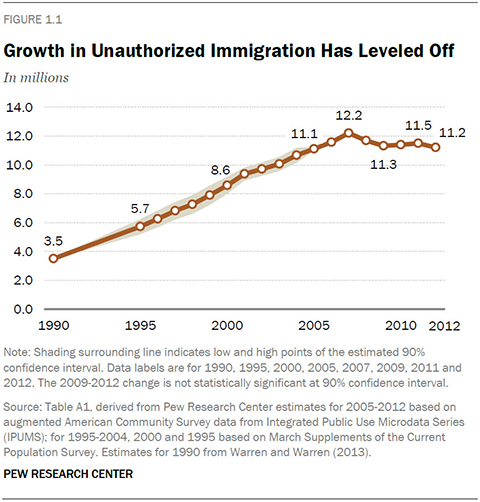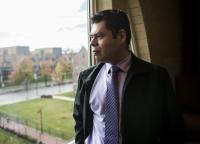President Obama’s immigration announcement this week shed light on what has become a swelling national problem: the more than 11 million immigrants living, working and establishing families in the United States illegally. His decision to act on his own hardly addresses that whole population or what politicians of all stripes describe as a broken immigration system, but it will nonetheless affect millions.
A new report this week from the Pew Research Center offers an updated and varied look at not only where those 11.2 immigrants live, but also how that population has changed. Here’s a look at 7 maps from the Pew report that offer some insight into the immigrant population by state:
1. The share of students with an undocumented parent
A key part of Obama’s announcement was aimed at the undocumented parents of children living here legally. Here’s how The Post’s David Nakamura explained it:
In an evening address from the White House, Obama outlined a plan to provide administrative relief and work permits to as many as 3.7 million undocumented parents of U.S. citizens and legal permanent residents, as well as an additional 300,000 young immigrants who were brought to the country illegally as children.
Pew estimates that 4 million undocumented immigrant parents lived with their U.S.-born minor or adult children in 2012. The map above offers a look at the population of minor children — at least those in kindergarten through 12th grade — with at least one undocumented parent.
Nationally roughly 1 in 15 — 6.9 percent — of K-12 students lived with an undocumented parent, according to Pew’s estimate. And the majority of those children were estimated to have been born in the United States. Nevada was home to the largest share — nearly 18 percent. That share was just above 13 percent in California and Texas, and exactly 11 percent in Arizona. It was as low as 0.1 percent in North Dakota and West Virginia.
2. The total unauthorized population
The map above shows the total undocumented immigrant population for each state, which largely reflects state populations overall. California, the most populous state, is home to the most: nearly 2.5 million undocumented immigrants. Texas is home to nearly 1.7 million. Six states — Maine, Montana, North Dakota, South Dakota, Vermont and West Virginia — have fewer than 5,000 undocumented immigrants. Nationally, there are 11.2 million such immigrants in all.
3. The undocumented immigrant share of each state’s population
While the previous map showed absolute numbers of undocumented immigrants by state, the map above shows the share of each state’s population they account for.
Undocumented immigrants make up a larger share of the population in Nevada — 7.6 percent — than in any other state. In California and Texas, undocumented immigrants account for 6.3 percent of the overall population, while they make up 5.8 percent in New Jersey and 4.8 percent in Florida. Just 0.2 percent of the population in Maine and West Virginia is undocumented.
4. The undocumented share of each state’s immigrant population
The map above tells a slightly different story. It shows what share of each state’s total immigrant population is living in the United States illegally.
In nine states, at least 40 percent of the overall immigrant population is estimated to be here illegally. Arkansas is ranked first, with 45 percent of its immigrants being undocumented.
Maine’s immigrants are virtually all living in the United States legally, with just 6 percent of its immigrant population being undocumented. Vermont is next with 9 percent, followed by North Dakota with 10 percent.
5. The share of workers in each state who are undocumented
More than 1 in 10 workers in Nevada are undocumented, according to Pew’s estimates, making it the state where such immigrants make up the largest share of the labor force.
Undocumented immigrants account for more than 5 percent of the labor force in 14 states overall. And they account for less than 1 percent of the work force in six states: West Virginia, Maine, Montana, Vermont, North Dakota and South Dakota.
6. The Mexican share of the undocumented population
Just over half — 52 percent — of the undocumented population nationwide is Mexican, according to Pew. But rates vary wildly by state.
In the border states of New Mexico and Arizona — and farther north in Idaho and Wyoming — more than 4 in 5 undocumented immigrants are Mexican. The size of the immigrant population was too small in six states to get accurate estimates, while Mexicans accounted for fewer than 1 in 10 undocumented immigrants in four states.
7. The undocumented population rose in 7 states and fell in 14 since 2009
From 2009 to 2012, 21 states saw statistically significant changes in their undocumented population. Populations rose in seven states and fell in 14.
The seven states included five along the East Coast — Florida, Maryland, New Jersey, Pennsylvania and Virginia — as well as Idaho and Nebraska.
Source Article from http://feeds.washingtonpost.com/c/34656/f/636635/s/40b6f4bd/sc/7/l/0L0Swashingtonpost0N0Cthe0Eundocumented0Eimmigrant0Epopulation0Eexplained0Ein0E70Emaps0C20A140C110C210C4a1ded620Eeead0E40A30A0Eb75f0E7af910Adaba0A90Istory0Bhtml0Dwprss0Frss0Inational/story01.htm
GovBeat: The undocumented immigrant population explained, in 7 maps
http://feeds.washingtonpost.com/c/34656/f/636635/s/40b6f4bd/sc/7/l/0L0Swashingtonpost0N0Cthe0Eundocumented0Eimmigrant0Epopulation0Eexplained0Ein0E70Emaps0C20A140C110C210C4a1ded620Eeead0E40A30A0Eb75f0E7af910Adaba0A90Istory0Bhtml0Dwprss0Frss0Inational/story01.htm
http://news.search.yahoo.com/news/rss?p=immigrant
immigrant – Yahoo News Search Results
immigrant – Yahoo News Search Results










